A small but relatively prominent constellation in the southern sky, lying just below Orion. The constellation is not hard to find as it is a fairly distinctive grouping of brighter constellations. Because of its more southerly declination, however, we must wait for its culmination to best see its objects. For a binocular or small telescope, however, only the globular cluster M79 and the blood-red Hind's Crimson Star are worth the effort to find.
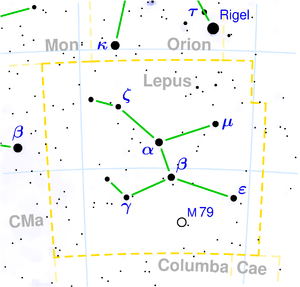
Arneb (α Lep) - The brightest star in the constellation (2.58mag) is located 2200 light-years away. It is a supergiant 32,000 times brighter than the Sun. At an angular distance of 36", it contains a faint companion of magnitude 11.
Nihal (β Lep) - triple star. At a star with a brightness of 2.8mag, there are two components at a separation of 2.5" and 64", both with a brightness of 11mag. The farther component is just an optical companion. The main star is located 160 light years away.
γ Lep - This binary star system splits into two components, one reaching 3.7 magnitude (yellow) and the other 6.3 magnitude (orange). The components are separated by 96.3" and are roughly 29 light-years away from Earth. The star belongs to the stellar cluster of Ursa Major.
κ Lep - This binary star is composed of components with magnitudes 4.5 and 7.4, which are separated by an angular distance of 2.6". To resolve them, a telescope with an objective diameter of at least 15 cm is needed. At approximately 115x magnification, both components appear white. Only in a larger telescope will the companion acquire a blue color.
Herschel 3780 - A small star cluster (NGC 2017), whose main members are listed in the Herschel catalog. A small telescope reveals a star of magnitude 6 with four companions of magnitude 8 to 10. In a larger telescope, it can be verified that two of the components are close binary stars. At the same time, a fainter star of magnitude 12, which complements the group, is also visible.
Herschel 3750 - This tight yellow-white-blue binary star was named by William Herschel as the "most beautiful binary star". It can be easily verified even with a smaller telescope. The components have magnitudes of 4.7 and 8.4, with a separation of 4.2".
Hindova karmínová hviezda (R Lep) - similarly to Mira Ceti, it is a red giant that changes its brightness usually in the range of 6mag to 11.7mag in a period of 430 days. The total difference between the maximum and minimum corresponds to a brightness difference of 300x. It also has a long secondary cycle - every 40 years the star brightens up to 5.5mag. At the time of maximum brightness, it resembles a vivid red drop of blood in the dark sky and is visible to the naked eye. It is located near μ Lep (3.31mag). R Leporis is a giant star with a low surface temperature of about 2,700 K, with carbon molecules in its atmosphere that absorb short-wavelength radiation and an extensive dust cloud that surrounds it. All of this is the cause of the star's red color, which stands out especially during the period of its maximum brightness. The star is visible with a hand-held telescope, but a telescope is needed for clear color distinction.
M 79
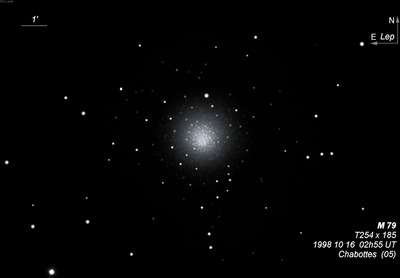
Pierre Méchain discovered M79 = NGC 1904 on 26 Oct 1780. He reported it to Messier, who confirmed its position, and included it in his 1780 catalogue. Wolfgang Steinicke reports that William Herschel first observed the cluster on 4 Mar 1783 (before his sweeps) with his 6.2-inch reflector. On 17 Nov 1784, WH recorded M79 as "a fine cluster of stars, near 3' dia. Extremely compressed but completely resolved." On 13 Jan 1806, he observed with his "Large 10 feet" and logged "The 79th of the Connoiss. is a cluster of stars of a globular construction, and certainly extremely rich. Towards the centre the stars are extremely compressed, and even a good way from it. With 171 the diameter is a little less than 1/3 of the field, and with 220 a little more; the field of one being 9'0", and of the other 8'0", a mean of both gives the diameter of the cluster 2'50", but I suppose that the lowness of the situation prevents my seeing the tiny scattered stars, so that this cluster is probably larger than it appears."
200/250mm - 8" (9/25/81): small bright core, a few stars are resolved at the edge of the mottled core. The outer halo is well resolved in excellent conditions.
300/350mm - 13" (1/19/85): at 360x, about 40 stars resolved in good seeing including a few over the core.
400/500mm - 17.5" (1/9/99): at 280x, M79 is well resolved into several dozen stars. Contains a sharply concentrated intense core, ~2' in diameter which is clumpy, mottled and partially resolved at its periphery. The inner part of the halo is peppered with faint stars. The background haze drops off significantly towards the outer portion of the halo but a number of brighter stars are resolved including a nice arc of stars along the following edge of the halo. A evenly matched close pair is on the northeast side and a mag 12 star (a post-AGB star that belongs to the cluster) is at the north edge. Located 35' NE of naked-eye 5th magnitude h3752 (5.5/6.7 at 3").
17.5" (12/8/90): 40-50 stars resolved mostly in the halo or at the edge of the very mottled core. A string of six stars is just east of center and a long string passes through the core. The brightest mag 12.5 star is north of the core.
17.5" (12/3/88): three dozen stars resolved, mostly at the edges of the core and in the halo.
17.5" (12/19/87): at 220x, three dozen stars were resolved.
Notes by Steve Gottlieb
IC 418
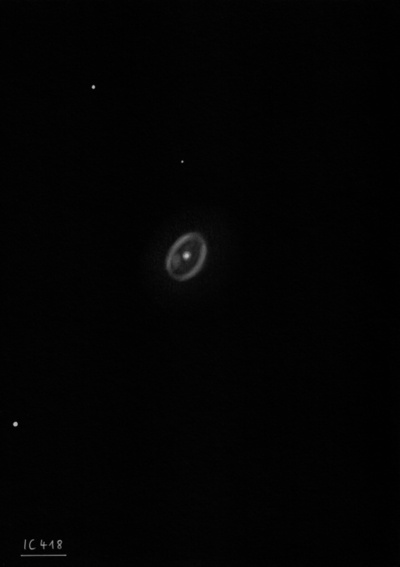
Williamina Fleming discovered IC 418 on 26 Mar 1891 based on a spectrum plate taken at Harvard College Observatory. In a letter communicated by Pickering in AN 3049, she mentioned the hydrogen spectrum [H-beta] was unusually large for a planetary. Pickering was attributed with the discovery in the NGC. W.W. Campbell, who credited Fleming with the discovery, made the first visual observation. In 1891 he reported "it is a beautiful object as seen in the 36-inch telescope [Lick], consisting of a 9th magnitude star surrounded by a circular disc of blue light nearly 15" in diameter."
Based on Crossley photographs, Curtis (1918) reported, "central star of mag 19, surrounded by a bright somewhat elliptical ring 14"x11" in outside diameter, and about 12"x10" along its central line; pa 163°." Walter Scott Houston may have made the first visual observation in 1945 using a 10" reflector.
A star is plotted at this position on the Uranometria 2000.0 Atlas because the BD catalogue included the central star.
200/250mm - 8" (2/5/81): nearly stellar at 100x, bright, appears as a mag 10 star with a small, faint bluish halo.
300/350mm - 13.1" (10/20/84): very bright, small, takes 350-410x well, bright central star, subtle shell structure.
400/500mm - 17.5" (2/22/03): at 100x, the bright 10.5 magnitude central star was centered in a 10" round halo with a definite rosy or raspberry tint at the outer edge of the halo, though the effect is fairly subtle. Using an H-beta filter, the central star is strongly dimmed but the halo is significantly enhanced, dramatically changing the view of this planetary. At 380x, no color was visible but the halo was a bit asymmetrical with a "softer" edge and possible double shell structure. The center was very slightly darker around the central star.
17.5" (12/30/99): at 82x the mag 10.5 central star was enveloped in a very small round halo which appeared to have a slight reddish tinge at its edge. This is a low-excitation PN and using a H-beta filter, the halo brightened and the central star faded, leaving a more noticeable disc. At 220x, the prominent central star was surrounded by a well-defined 10" halo that partially "blinked" on and off switching from averted to direct vision. At 280x, the small halo was possibly surrounded by an extremely faint envelope, but this could not be confirmed. 380x and 500x presented a superb view of the inner disc which appeared weakly annular.
17.5" (3/8/97): unusually bright mag 10.5 central star surrounded by a small high surface brightness halo. At 220x, this planetary has a distinct "blinking" effect; staring at central star partially washes out the halo and with averted the halo is more dominant. At 82x, an unusual rosy tinge is evident at the edge of the small halo, although the effect is fairly subdued. The seeing was not steady enough for high power viewing of the outer shell.
17.5" high surface brightness planetary, appears very bright at 481x. Contains a bright "fuzzy" central star with a bright inner portion surrounded by a second fainter shell slightly elongated N-S.
900/1200mm - 48" (2/18/12): at 488x, the sharply defined, vivid raspberry annulus appeared relatively thin and extended NNW-SSE, ~14"x12". The high contrast central dark hole was striking surrounding the bright central star. Surrounding the annulus is a faint outer halo, increasing the size to roughly 20".
48" (4/2/11): truly impressive view at 375x and 488x, which revealed a very high surface brightness, slightly elongated halo, ~14"x12", surrounding the very bright central star. I was surprised to see the planetary was clearly annular with a very bright, irregular rim that varied slightly in thickness and a fairly high contrast darker hole surrounding the central star. The ring's outer rim was a shocking, deep raspberry color. The color was more intense at 375x and slightly more saturated along one-half of the annulus.
Notes by Steve Gottlieb
NGC 1964
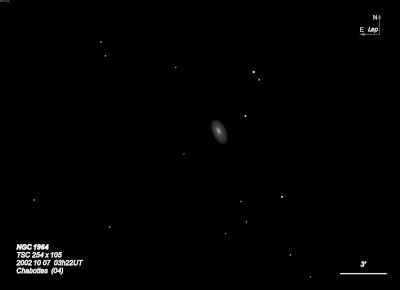
William Herschel discovered NGC 1964 = H IV-21 = h2860 on 20 Nov 1784 (sweep 325) and recorded "vS, stellar, the nucleus very brigh; the chevelure vF and not perfectly central; there seems to be a vS star preceding it." His RA is 13 sec too large, but the identification is certain. John Herschel observed this galaxy from the Cape of Good Hope and recorded "F, irregularly round, vsbM, to a star 12th mag, 2 or 3 stars involved, and several bright ones near." His position was accurate.
300/350mm - 13" (12/18/82): faint, elongated, small bright nucleus, fairly small, faint halo surrounded core.
400/500mm - 17.5" (12/3/88): fairly faint, fairly large, very elongated 3:1 SSW-NNE, unusually bright stellar nucleus. A mag 13.5 star is at the west edge 0.7' from center and a mag 14 star is at the SSW edge of the major axis 1.2' from center. Situated just southeast of a thin triangle of mag 9.5-10.5 stars, the closest being mag 9.3 SAO 170546 1.7' NW of center.
Notes by Steve Gottlieb
NGC 2196
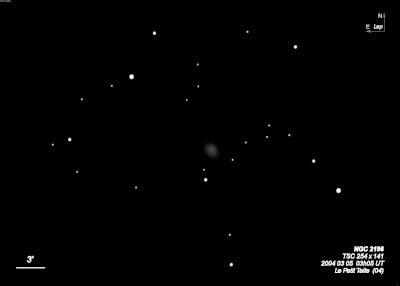
William Herschel discovered NGC 2196 = H II-265 = h3024 on 20 Nov 1784 (sweep 325) and logged "pF, pS, iF, bM of an irregular shape, somewhat elongated." His position is 30 sec of RA too large and 3' too far south. JH observed this galaxy from the Cape on 4 sweeps, first recording it as "B, pL, R, pspmbM. Many stars near it." His position is accurate.
300/350mm - 13.1" (1/28/84): fairly bright, fairly small, almost round, increases to a small bright core.
Notes by Steve Gottlieb
NGC 1832
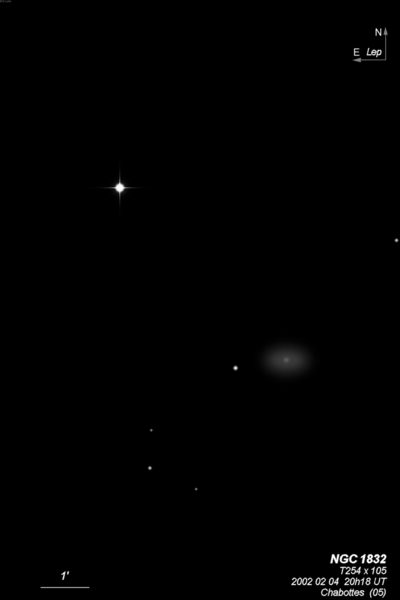
William Herschel discovered NGC 1832 = H II-292 on 4 Feb 1785 (sweep 365) and reported "pB, irr R, mbM, south-preceding a pretty considerable star and within a minute of it." His position is 2.3' SE of MCG -03-14-010 = PGC 16906.
300/350mm - 13.1" (12/18/82): fairly bright, bright core, slightly elongated ~N-S. A mag 11 star is 1.0' E of center. Situated 33' NNW of mag 3.3 Mu Leporis.
600/800mm - 24" (1/28/17): at 375x; bright, fairly large, oval 4:3 N-S, 1.6'x1.2', well concentrated with a small bright core. A mag 11 star is 1.1' E of center.
Notes by Steve Gottlieb
NGC 2139
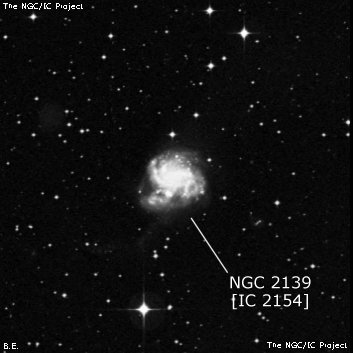
200/250mm - 8" (1/1/84): faint, fairly small, round, broad concentration. A mag 11 star is 4' SSE.
400/500mm - 17.5" (12/8/90): moderately bright, moderately large, slightly elongated, broad concentration, core appears offset to the northwest of center. A mag 14 star is at the north edge 1.3' from center and a mag 11 star lies 3.5' SSE.
Notes by Steve Gottlieb
NGC 1954
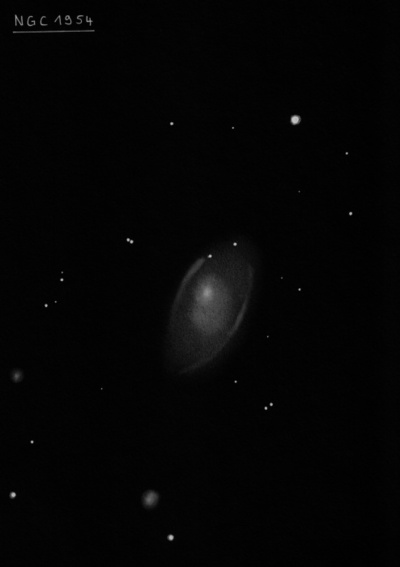
William Herschel discovered NGC 1954 = H III-590 = h2853 on 14 Dec 1786 (sweep 647) and recorded "suspected, eF, stellar, not very doubtful." His position is accurate. JH observed it from the Cape and noted "vF, R, 25"." Both Herschels missed nearby NGC 1957.
400/500mm - 17.5" (12/3/88): faint, small, slightly elongated, bright core, faint stellar nucleus. A mag 13.5 star is off the northwest edge 1.3' from center. Forms a pair with NGC 1957 5' SSE.
600/800mm - 24" (12/28/16): at 225x; moderately bright and large, sharply concentrated with small, very bright core ~20"x15" N-S. The core is surrounded by a low surface brightness halo without a well defined edge but roughly 1.25' diameter. A mag 13 star is superimposed 45" N of center and a mag 13.8 star is 1.3' NW (outside the halo).
NGC 1954 is the brightest in a trio (HDCE 361) at a distance of ~150 million years with NGC 1957 4.5' SSE and IC 2132 9.5' NNW. The three galaxies are nearly collinear.
Notes by Steve Gottlieb
NGC 1888
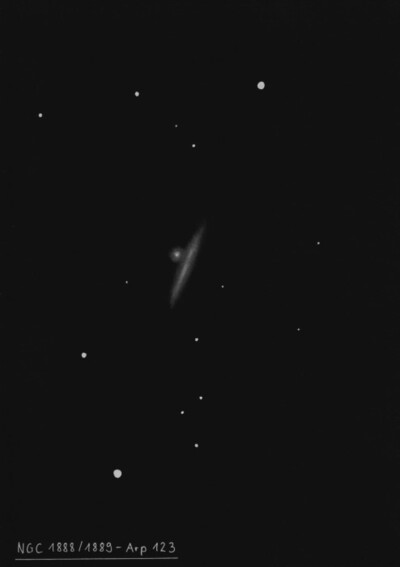
William Herschel discovered NGC 1888 = H II-289 = h352 = h2806 on 31 Jan 1785 (sweep 362) and recorded as "F, pL, irregular triangular figure, resolvable." I'm surprised he missed NGC 1889, which was discovered by Bindon Stoney at Birr Castle on 29 Oct 1851. Joseph Turner sketched the pair of galaxies (Arp 123) on 4 Jan. 1877 with the 48" Great Melbourne Telescope.
200/250mm - 8" (10/13/81): very faint, small.
300/350mm - 13.1" (12/22/84): fairly faint, very elongated 3:1 NW-SE streak. Forms a contact pair with NGC 1889 just NE of the center.
900/1200mm - 48" (2/18/12): very bright, large, elongated 5:1 NW-SE, 2.4'x0.5'. Contains a very bright, elongated core that appears mottled. The northwest extension is partially cut off in a north-south direction due to a dust lane near the midpoint and the northwest end has a much lower surface brightness.
48" (10/22/11): very bright, large, edge-on 5:1 NW-SE, 2.6'x0.5', large bright core. Forms a striking pair with NGC 1889, which is attached on the east side of the core.
Notes by Steve Gottlieb
IC 408
AM 0517-250, a close double system, lies 2.5' SSE. The brighter northern component (ESO 486-053A = PGC 17114) appeared faint, small, round, 12" diameter, very faint stellar nucleus.
Lewis Swift discovered IC 2121 = Sw. XI-75 on 26 Dec 1897 and recorded "eeeF; S; R; 7m * 15s p[receding] obliterates it; eee diff." There is nothing at his position but 30 seconds of RA east and 1.5' N is ESO 486-053 and this galaxy matches his description of the nearby bright star 15 seconds of RA west. In his survey of NGC/IC objects at the turn of the century, Howe measured an accurate position (used in the IC) and gave a more accurate offset for the bright star. Swift might have found this galaxy again on 2 Feb 1889 while on a visit to Barnard at Lick Observatory. See IC 408 for that story.
600/800mm - 24" (2/13/18): at 375x; fairly faint, fairly small, elongated 3:2 NNW-SSE, 30"x20", very small brighter nucleus, only a very small halo was visible, though occasionally the galaxy elongated into a 2:1 ratio. Located 4.8' NE of mag 7.0. The star was distracting so the best view was by placing it outside the field.
Notes by Steve Gottlieb
HCG 32
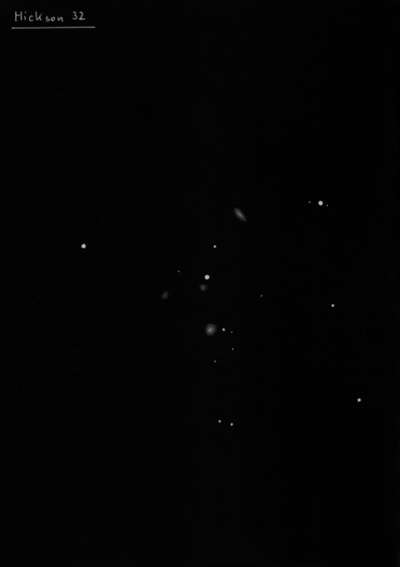
| Type | GALCL [E1] |
| RA | 05:01:42.9 |
| Dec | -15:25:12.0 |
| major_axis | 3.9' |
| mag | 12.7 |
| surface_bright | 99.9 |
Abell 7
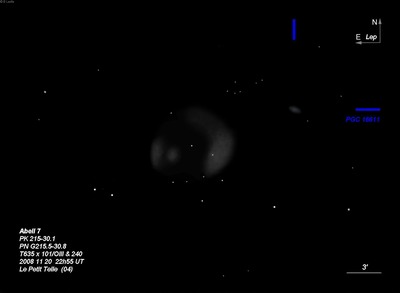
| Type | PN [3a] |
| RA | 05:03:07.5 |
| Dec | -15:36:23.0 |
| major_axis | 12.7' |
| mag | 13.2 |
| surface_bright | 18.5 |